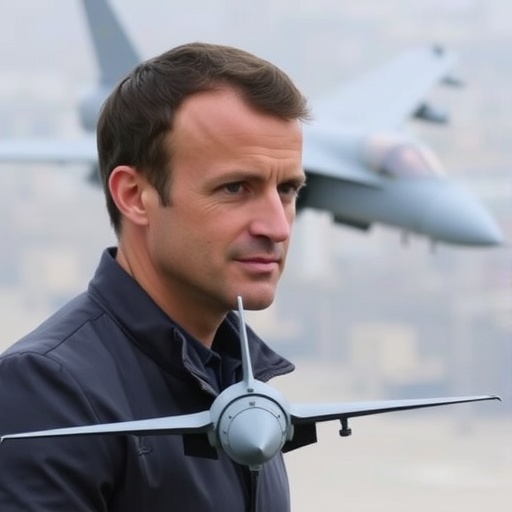France Escalates Ukraine Military Aid: Macron Pledges Mirage Jets and Aster Missiles in Bold Move Against Russia
In a striking escalation of Western support for Ukraine’s defense against Russian aggression, French President Emmanuel Macron has announced the immediate delivery of advanced Mirage-2000 fighter jets and additional Aster missiles for air defense systems. This move, set to unfold in the coming days, underscores France‘s unwavering commitment to bolstering Ukraine’s military capabilities amid intensifying aerial threats from Moscow.
- Macron’s Announcement Ignites New Chapter in Franco-Ukrainian Alliance
- Mirage-2000 Jets: A Game-Changer for Ukraine’s Skies
- Aster Missiles Bolster Air Defense Amid Surging Russian Attacks
- Coalition of the Willing Ramps Up Pressure on Russia’s War Machine
- Future Horizons: How French Aid Could Reshape the Battlefield
The announcement comes at a pivotal moment in the ongoing conflict, where Ukrainian forces have faced relentless Russian drone and missile strikes. Macron’s pledge not only enhances Ukraine’s air defense but also signals a unified front from the Coalition of the Willing, a group of NATO allies determined to counter Russian advances without direct troop involvement.
Macron’s Announcement Ignites New Chapter in Franco-Ukrainian Alliance
President Macron made the revelation during a high-level address in Paris on Tuesday, emphasizing France‘s role as a frontline supporter in the international effort to aid Ukraine. “We cannot stand idly by while Russia’s unprovoked war ravages Europe,” Macron stated, his voice resolute as he outlined the specifics of the aid package. This delivery includes up to a dozen refurbished Mirage-2000 multi-role fighter jets, capable of engaging enemy aircraft and conducting precision strikes, alongside hundreds of Aster 30 missiles designed for the SAMP/T (Surface-to-Air Missile Platform/Terrain) systems already operational in Ukraine.
The SAMP/T, often dubbed Europe’s Patriot, has proven vital in intercepting Russian Kinzhal hypersonic missiles and Shahed drones. Since its deployment in Ukraine last year, the system has reportedly neutralized over 150 aerial threats, according to Ukrainian Defense Ministry figures. Macron’s decision to replenish its missile stocks addresses a critical shortfall, as Ukraine has expended vast quantities defending key cities like Kyiv and Kharkiv from bombardment.
This isn’t France’s first foray into Ukraine military aid. Since Russia’s full-scale invasion in February 2022, Paris has provided over €3 billion in support, including Caesar howitzers, armored vehicles, and training for Ukrainian pilots. However, the inclusion of Mirage jets marks a qualitative leap, transitioning from ground-based assistance to aerial empowerment. Experts note that training Ukrainian pilots on these jets could take just weeks, given prior NATO interoperability exercises.
Macron’s rhetoric framed the aid as a deterrent: “By strengthening Ukraine’s skies, we send a clear message to the Kremlin that aggression will meet resolve.” This comes amid reports of Russian forces amassing near the Donbas region, where recent satellite imagery from the European Space Agency shows increased troop concentrations, potentially signaling a spring offensive.
Mirage-2000 Jets: A Game-Changer for Ukraine’s Skies
The Mirage-2000, a stalwart of the French Air Force since the 1980s, brings cutting-edge technology to Ukraine’s embattled airspace. These single-engine fighters, equipped with advanced radar systems like the RDY-2, can detect targets at over 100 kilometers and engage with Mica air-to-air missiles. In the context of Ukraine military aid, the jets’ versatility—capable of both air superiority missions and ground attacks—positions them as a direct counter to Russia’s Su-35 fleet, which has dominated eastern Ukrainian skies.
France plans to deliver the initial batch of six Mirage jets by mid-May, with the remainder following by summer. Each aircraft will be retrofitted with Ukraine-compatible avionics, ensuring seamless integration into Kyiv’s existing fleet of Soviet-era MiG-29s and recently acquired F-16s from other donors. Ukrainian Air Force commander Mykola Oleshchuk praised the move in a Telegram post: “These Mirages will tip the scales, allowing us to protect our people from the terror raining from above.”
Historically, the Mirage-2000 has seen action in conflicts from the Gulf War to Libya, boasting a combat-proven record with over 90% mission success rates in simulated NATO exercises. For Ukraine, where air defenses have intercepted 85% of incoming missiles in recent months per Pentagon assessments, these jets could extend that protection further, potentially reducing civilian casualties that have exceeded 10,000 since the war’s onset, according to UN estimates.
Behind the scenes, French defense firm Dassault Aviation is accelerating maintenance, drawing from surplus stocks to avoid depleting active French squadrons. This logistical feat highlights the depth of France’s industrial commitment, with production lines in Bordeaux ramping up to support ongoing supplies.
Aster Missiles Bolster Air Defense Amid Surging Russian Attacks
Complementing the Mirage jets, the Aster missiles represent a cornerstone of enhanced air defense for Ukraine. Developed by Eurosam, a Franco-Italian venture, these vertical-launch interceptors offer 360-degree coverage and can neutralize threats at altitudes up to 25 kilometers. In the SAMP/T batteries, they’ve already demonstrated efficacy against Iskander ballistic missiles, which Russia deploys from Belarus and Crimea.
France’s shipment includes 200 Aster 30 Block 1NT variants, optimized for anti-ballistic defense. This influx is timely, as Russian strikes have escalated: In the past month alone, Moscow launched over 500 drones and missiles, per Ukrainian intelligence, targeting energy infrastructure and causing blackouts affecting millions. The Aster system’s hit rate, exceeding 95% in tests by the French Directorate General of Armaments, could safeguard critical assets like the Zaporizhzhia nuclear plant, recently threatened by proximity fire.
Integration challenges are minimal, as Ukrainian crews trained on SAMP/T last fall under French auspices at a base near Lyon. “This aid saves lives,” said Ukrainian Foreign Minister Dmytro Kuleba in a joint presser with Macron. “Every missile counts in our fight for survival.” Economically, the delivery underscores Europe’s pivot to defense spending; France’s 2024 budget allocates €413 billion to military needs, partly fueled by Ukraine’s plight.
Broader context reveals a patchwork of air defense support: While the U.S. provides Patriots, Germany’s IRIS-T, and Italy’s own SAMP/T contributions, France’s Aster focus fills a high-altitude gap. Analysts from the International Institute for Strategic Studies predict this could reduce Russia’s aerial effectiveness by 30%, forcing tactical shifts and buying time for Ukraine’s counteroffensives.
Coalition of the Willing Ramps Up Pressure on Russia’s War Machine
The French pledge is embedded within the Coalition of the Willing, an ad hoc alliance of 50-plus nations coordinating Ukraine military aid outside NATO’s formal structure. Formed in 2022, the group has delivered $100 billion in assistance, including artillery, tanks, and now advanced aircraft. Macron’s announcement aligns with recent commitments from the UK (Storm Shadow missiles) and Poland (additional MiG-29s), creating a crescendo of support as Russia’s economy strains under sanctions—GDP growth projected at a mere 0.3% for 2024 by the IMF.
Diplomatic ripples are immediate: Russia’s Foreign Ministry decried the move as “escalatory,” warning of NATO encirclement, while U.S. President Joe Biden echoed approval, stating, “France’s leadership inspires us all.” Within the EU, this bolsters Macron’s vision of “strategic autonomy,” countering criticisms of European hesitancy. Polls from Ifop show 62% of French citizens back the aid, up from 45% in 2022, reflecting shifting public sentiment amid war fatigue.
Logistically, the coalition’s Ramstein Air Base hub in Germany facilitates transfers, with French C-130 transports slated for the first shipments. Security concerns, including potential Russian sabotage, have prompted enhanced escorts, drawing on lessons from earlier aid convoys ambushed near the Polish border.
Future Horizons: How French Aid Could Reshape the Battlefield
Looking ahead, the Mirage jets and Aster missiles could catalyze a Ukrainian air renaissance, enabling deeper strikes into occupied territories and protecting supply lines vital for Western munitions. With pilot training underway in Romania, full operational status might arrive by autumn, coinciding with potential NATO summits where further aid pledges could emerge.
Strategically, this pressures Russia to negotiate; Kremlin insiders, per leaked FSB documents reported by Meduza, express alarm over depleting air assets. For Ukraine, sustained France-led Ukraine military aid preserves sovereignty, potentially deterring escalation while fostering long-term defense ties—Macron hinted at post-war joint ventures in aviation.
Yet challenges persist: Maintenance demands on Mirage jets require ongoing French expertise, and Aster production faces supply chain hurdles from global chip shortages. Nonetheless, this infusion fortifies Europe’s eastern flank, signaling that the free world’s resolve remains unbroken. As Macron concluded, “Together, we defend not just Ukraine, but our shared future.”









